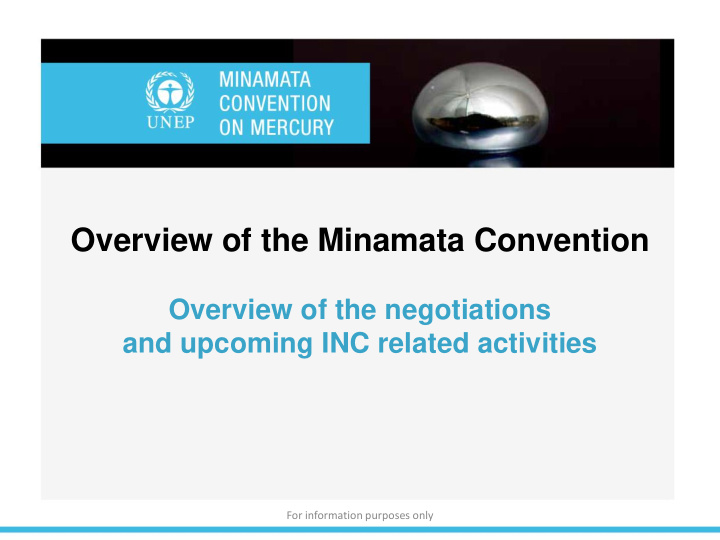



Overview of the Minamata Convention Overview of the negotiations and upcoming INC related activities For information purposes only
The information contained in this presentation is for information only and shall not be reproduced. It does not represent an interpretation of the text of the Minamata Convention by UNEP or the Interim Secretariat of the Minamata Convention and does not substitute the original authentic texts of the Minamata Convention on Mercury as deposited with the Secretary General of the UN acting as the Depositary of the Convention. For information purposes only
Main steps of the negotiations process 2001 – Global mercury assessment initiated 2003 – Governments agree on the need for global action on mercury, based on its adverse health and environment effects and its long range transport in the environment 2007 – Governments agree to consider the need for a legally binding instrument to further address the mercury issue 2009 – Governments agree to negotiate a global legally binding instrument on mercury and establish the intergovernmental negotiating committee (INC) For information purposes only
for information purposes only
Main steps of the negotiations process Diplomatic Conference, OEWG INC1 INC3 Japan, 2013 INC2 Bangkok INC4 Stockholm Nairobi INC5 Chiba UNEP GC Punta del Geneva Este decision 2009 2010 2011 2012 2013 2001-2008 2009-2013 2014-2017? 2018 onwards
Main steps of the negotiations process 19 January 2013: Governments agreed to the text of the “Minamata Convention on Mercury” 10 October 2013: Text of the Minamata Convention adopted and opened for signature in Kumamoto, Japan Convention opened for signature until 9 October 2014 24 September 2014: Special high-level event on the Minamata Convention in the context of the Treaty event at the UN headquarters in New York
As of 2 September 2014, 102 Signatures and 1 Party For information purposes only
Next steps Entry into force: 90 th day after the date of deposit of the 50 th • instrument of ratification, acceptance, approval or accession Preparation for entry into force will be assisted by further meetings of • the intergovernmental negotiating committee – INC6 from 3 to 7 November 2014 in Bangkok, Thailand – 24+ working documents for consideration at INC6 – Side events at INC6 – Global Mercury Partnership Advisory Group before INC6 Intersessional period Support for early implementation and ratification underway • Expert Group on BAT/BEP • Outreach and awareness raising material • Technical support available • For information purposes only
Overview of the Convention text For information purposes only
Highlights of the Convention • Preamble – sets background for the Convention, establishes previous relevant decision, cooperative actions • Objective (article 1) – to protect the human health and the environment from anthropogenic emissions and releases of mercury • Definitions (article 2) – sets out definitions used in more than one Article of the Convention. Some articles include definitions specific to that article For information purposes only
Highlights of the Convention Articles can be divided into four main categories : Operational articles - describe the obligations on Parties which will reduce anthropogenic emissions and releases of mercury and mercury compounds to the environment Support to Parties - financial resources, capacity building, technical assistance and technology transfer, implementation and compliance committee Information and awareness raising , including actions which will reduce impacts of mercury Administrative matters For information purposes only
Highlights of operational articles Controls on all lifecycle stages of mercury covered by different articles of the Convention Controls on supply and on international trade in mercury (Article 3) • Phase-out and phase-down for mercury use in products and • processes (Articles 4, 5 and 6) Controls on artisanal and small scale gold mining (Article 7) • Control measures on air emissions and releases to water (Articles 8 • and 9) Storage, waste and contaminated sites (Article 10, 11 and 12) • For information purposes only
Support to Parties The Convention has obligations on support to be provided to parties, including : Financial mechanism (Article 13) The Global Environment Facility Trust Fund • A specific international Programme to support capacity- • building and technical assistance. Capacity building, technical assistance and technology transfer (Article 14) Implementation and Compliance Committee (Article 15) For information purposes only
Information and awareness raising Health aspects (Article 16) • Information exchange (Article 17) • Public information, awareness and education (Article 18) • Research, development and monitoring (Article 19) • Implementation plans (Article 20) • Reporting – required by all Parties (Article 21) • Effectiveness evaluation (Article 22) • For information purposes only
Administrative Articles Establish Conference of the Parties (Article 23) Establish Secretariat, hosted by UNEP (Article 24) Standard administrative articles (Articles 25 to 35): – Settlement of disputes – Amendments to the Convention – Adoption and amendment of annexes – Right to vote, signature, ratification etc., entry into force, reservations, withdrawal, depositary, authentic texts For information purposes only
Recommend
More recommend